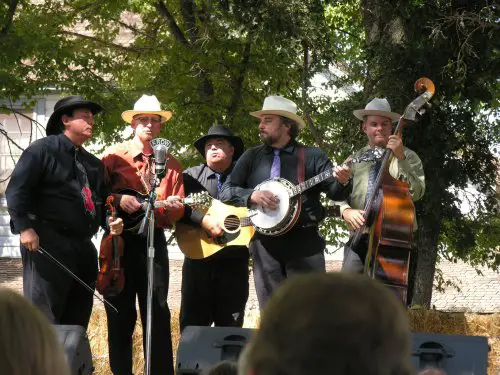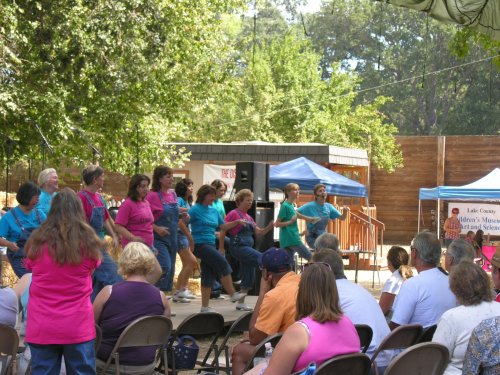LAKE COUNTY – How do local schools measure up? Newly released Academic Performance Index, or API, results show how the county's schools are making the grade when it comes to state performance standards.
The API is a weighted average of student test scores, explained Tim Gill, director of curriculum and instruction for the Lake County Office of Education. The testing system rates schools on a numeric index with a low of 200 and a high of 1,000; the statewide target is 800.
Gill said when students take the California standards test, they're given a score: 1,000 for advanced, 875 for proficient, 700 for basic, 500 for below basic and 200 for far below basic. If every student received the top score, the school's API would be 1,000.
The test's subjects are weighted differently, said Gill, with English language arts counting higher than math, which in turn is ranked higher than social studies and science.
“The state and federal accountability reports provide educators, parents, and our communities with important data about student progress in their schools,” said state Superintendent of Public Instruction Jack O'Connell, when he released the results earlier this month. “The results show that our schools are making real progress and that more students in California are meeting the challenge of higher expectations.”
According to O'Connell's office, 53 percent of schools in California made their API growth targets based on 2008 data, an increase of 8 percentage points from 2007. Locally, 11 schools met both their schoolwide and subgroup growth targets, according to test score data.
Thirty-six percent of all California schools are now at or above the target of 800, up 5 percentage points from the year before. In Lake County, two schools, Riviera Elementary and Cobb Mountain Elementary, are among the schools above that target number.
Overall, O'Connell pointed to some narrowing of the achievement gap between white and Asian students and their peers who are black, Hispanic or English learners. O'Connell said the API gives schools more credit for improvement made by the lowest-achieving students, "which encourages educators to focus on improving the achievement of students who struggle the most."
Black students statewide increased their API this year by 14 points and Hispanic students by 17 points; at the same time, white students increased by 10 points and English-learner students increased by 14 points.
California's high school exit exam is a part of the scoring for high schools, said Gill. Students who pass receive 1,000 points, those who don't receive 200 points. "So it's all or nothing."
In general, the county's high school exit exams scores also have been very good and fairly consistent in recent years, said Gill. The test's questions are written to middle school standards.
The most recent scores indicate that 75 percent of students countywide passed the test's language arts component. "That's a fairly high rate of passing," said Gill.
For the math component, test results show 73 percent of county students passed.
Students first take the test in 10th grade. The passing percentages go down considerably, Gill pointed out, as older students who didn't pass the test the first time are retested; those students are part of a group not proficient with standards.
Gill said California's target for all of its schools is an API of 800. For schools scoring below 600, each year they have a 5-percent minimum annual score improvement; schools with scores of 700 or above have a minimum improvement goal of five point. Those above 800 don't have a required annual goal.
Included in the scoring is a measurement for each of certain specific subgroups based on socio-economically disadvantaged students and those belonging to certain ethnic groups or English learners.
Gill said almost all of Lake County's schools have shown dramatic improvement when comparing recent scores to those from 2004-05.
"As a county over the last four or five years, we've seen incredible growth in our API, as has the state," he said. However, comparatively, local schools are about in the same place.
He said it's hard to know if the testing is actually improving the quality of education. The tests are based on content standards of which all teachers and districts are aware.
"What the testing system has done, it has encouraged our schools and districts to pay attention to that set of content standards," he said.
A potential down side of that, said Gill, is less flexibility in the subject matter the schools can teach.
Has the test improved education? "I don't feel like I can answer that question," said Gill.
Gill said some people feel that the test have caused schools to lose a lot, like physical education classes in elementary school and art.
Tomorrow: Local superintendents share their perspectives on the testing.
Local school test scores
Kelseyville Unified School District
Elementary schools
Kelseyville Elementary: 2008 score, 781; 2007 score, 790; growth target, 5; actual growth, -9; did not meet schoolwide or subgroup growth targets.
Riviera Elementary: 2008 score, 819; 2007 score, 811; school scored above state target so there were no stated goals; actual growth, 8; did not meet subgroup growth target.
Middle schools
Mountain Vista Middle: 2008 score, 723; 2007 score, 701; growth target, 5; actual growth, 22; met statewide and subgroup growth targets.
High schools
Kelseyville High School: 2008 score, 701; 2007 score, 683; growth target, 6; actual growth, 18; met statewide and subgroup growth targets.
Konocti Unified School District
Elementary schools
Burns Valley Elementary: 2008 score, 711; 2007 score, 689; growth target, 6; actual growth, 22; met schoolwide growth target but not subgroup growth target.
East Lake Elementary: 2008 score, 720; 2007 score, 756 (API was calculated for a small school; the calculations are less reliable and should be carefully interpreted); growth target, 5; actual growth, -36; did not meet schoolwide or subgroup growth targets.
Lower Lake Elementary: 2008 score, 757; 2007 score, 727; growth target, 5; actual growth, 30; met schoolwide and subgroup growth targets.
Pomo Elementary: 2008 score, 719; 2007 score, 673; growth target, 6; actual growth, 46; met schoolwide and subgroup growth targets.
Middle schools
Oak Hill Middle: 2008 score, 652; 2007 score, 644; growth target, 8; actual growth, 8; met schoolwide growth target but not subgroup growth target.
High schools
Lower Lake High: 2008 score, 626; 2007 score, 646; growth target, 8; actual growth, -20; did not meet schoolwide or subgroup growth targets.
Small schools
Richard H. Lewis Alternative: 2008 score, 745 (API was calculated for a small school; the calculations are less reliable and should be carefully interpreted); 2007 score, 643; growth target, 8; actual growth, 102; met schoolwide and subgroup growth targets.
Alternative Schools Accountability Model (ASAM) schools
Blue Heron: 2008 score, 449 (API was calculated for a small school; the calculations are less reliable and should be carefully interpreted); 2007 score, 465; growth target not applicable; actual growth, -16; schoolwide and subgroup growth targets do not apply.
William C. Carle High (Continuation): 2008 score, 687 (API was calculated for a small school; the calculations are less reliable and should be carefully interpreted); 2007 score, 682; growth target not applicable; actual growth, 5; schoolwide and subgroup growth targets do not apply.
Lakeport Unified School District
Elementary schools
Lakeport Elementary: 2008 score, 751: 2007 score, 787; growth target, 5; actual growth, -36; did not meet schoolwide or subgroup growth targets.
Middle schools
Terrace: 2008 score, 766; 2007 score, 741; growth target, 5; actual growth, 25; met schoolwide and subgroup growth targets.
High schools
Clear Lake High: 2008 score, 747; 2007 score, 727; growth target, 5; actual growth, 20; met schoolwide and subgroup growth targets.
Small schools
Lakeport Alternative (Home School): 2008 score, 696 (API was calculated for a small school; the calculations are less reliable and should be carefully interpreted); 2007 score, 759; growth target, 5; actual growth, -63; met subgroup growth target but not schoolwide growth target.
ASAM schools
Natural High (Continuation): 2008 score, 545 (API was calculated for a small school; the calculations are less reliable and should be carefully interpreted); 2007 score, 520; growth target not applicable; actual growth, 25; schoolwide and subgroup growth targets do not apply.
Lucerne Elementary School District
Lucerne Elementary: 2008 score, 727; 2007 score, 749; growth target, 5; actual growth, -22; did not meet schoolwide or subgroup growth targets.
Middletown Unified School District
Elementary schools
Cobb Mountain Elementary: 2008 score, 855; 2007 score, 847; school scored above state target so there were no stated goals; actual growth, 8; met schoolwide and subgroup growth targets.
Coyote Valley Elementary: 2008 score, 792; 2007 score, 818; school scored above state target so there were no stated goals; actual growth, -26; did not meet schoolwide or subgroup growth targets.
Minnie Cannon Elementary: 2008 score, 732; 2007 score, 721; growth target, 5; actual growth, 11; met schoolwide growth target but not subgroup growth target.
Middle schools
Middletown Middle: 2008 score, 795; 2007 score, 787; growth target, 5; actual growth, 8; met schoolwide and subgroup growth targets;
High schools
Middletown High: 2008 score, 718; 2007 score, 719; growth target, 5; actual growth, -1; did not meet schoolwide or subgroup growth targets.
Small schools
Lake County International Charter: 2008 score, 752 (API was calculated for a small school; the calculations are less reliable and should be carefully interpreted); 2007 growth, 720; growth target, 5; actual growth, 32; met schoolwide and subgroup growth targets.
Upper Lake Union Elementary School District
Elementary schools
Upper Lake Elementary: 2008 score, 704; 2007 score, 701; growth target, 5; actual growth, 3; did not meet schoolwide or subgroup growth targets.
Middle schools
Upper Lake Middle: 2008 score, 681; 2007 score, 672; growth target, 6; actual growth, 9; met schoolwide growth target but not subgroup growth target.
Upper Lake Union High School District
Upper Lake High: 2008 score, 682; 2007 score, 671; growth target, 6; actual growth, 11; met schoolwide and subgroup growth targets.
ASAM schools
Upper Lake Community Day: 2008 score, 430 (API was calculated for a small school; the calculations are less reliable and should be carefully interpreted); the school did not have a valid 2007 Base API and will not have any growth or target information.
Schools that were not listed did not have any testing information reported.
E-mail Elizabeth Larson at This email address is being protected from spambots. You need JavaScript enabled to view it..
{mos_sb_discuss:2}

 How to resolve AdBlock issue?
How to resolve AdBlock issue? 









